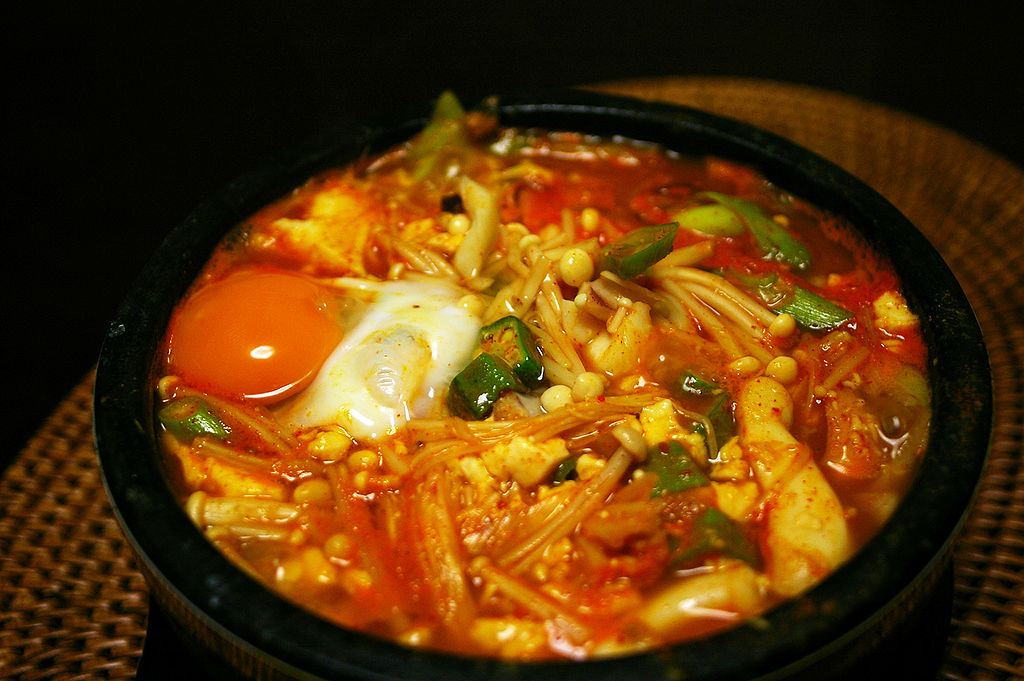
You might also like:
SOUTH KOREA plays host to an exciting, ever-growing cuisine; so familiar to us, yet so oddly distinct.
Meanwhile, fermented cabbage or kimchi is something of an obsession in Korea and is eaten alongside anything and everything. Here are ten dishes that are popularly consumed in South Korea; must-try foods if traveling to the area.
Soondubu jjigae (soft tofu stew)
Pic: Wikimedia Commons
In cold weather, there are only a few things more comforting than a bubbling cauldron of soondubu jjigae. Tofu and vegetables are cooked in a fiery red broth made of Korean chilli paste, and a raw egg is cracked over the top just before serving. Sometimes, mushrooms, onions or pork belly are added on request. In most restaurants, the dish is assembled and cooked at the table, and steaming white rice is served on the side.
Tteokbokki (spicy rice cake)

Pic: Asia Food
These tubular rice cakes can be found at many street vendors, and is a must-try for first-time visitors. The midlly sweet snack is made from garaetteok, a long, chewy cylindrical rice cake cut into pieces, stir-fried with Korean chilli paste, seasoned beef, vegetables and fish cakes. They’re easy to devour on the street, sold cheaply and absolutely delicious. Just remember to request for your preferred spiciness level with the vendor before purchasing.
Naengmyeon (cold noodles)

Pic: James/flickr
The dish’s title literally translates to cold noodles, but there’s a little bit more to it. Cold, thin, springy noodles made from buckwheat or arrowroot flour are dipped in an icy, tangy broth and garnished with sliced beef or pork, a boiled egg, Korean pear slices, sliced cucumber, green onions and sesame seeds. There are many restaurants that specialize solely in naengmyeon, and it’s worth trekking them down, especially in the summer.
Bibimbap (mixed rice)

Pic: Wikimedia Commons
Bibimbap is synonymous with Korean cuisine, and possibly the most accessible Korean dish in the West. It’s a bowl of colours, flavours and textures like no other. Warm rice is scooped into a bowl before topped with a melange of ingredients such as sautéed carrots, julienned cucumber, pickled radish, Korean chilli paste, soy sauce, sliced beef and a raw egg. Before eating, use a pair of chopsticks to stir the egg and vegetables with the rice until it becomes a gooey, delicious mess.
Jeon (pancake)

Pic: Kimchi&Me
Jeon is the umbrella term for the many types of savoury pancakes offered in Korea. Sometimes, sliced beef, chicken, seafood or vegetables are coated in batter and pan-fried till crisp on the edges while soft and fluffy on the inside. One of our favourite variations of this dish is pajeon, stuffed generously with sliced green onions for a nice kick. In restaurants, the pancakes are cut into squares and served with a soy-based dipping sauce.
Japchae (sweet potato noodles)

Pic: Daniel Go/flickr
The Koreans love their sweet potato. This dish – which can be eaten hot or cold – is made of sweet potato noodles, or clear glass noodles made of sweet potato starch and water. When in its dry form, the noodles are dry and gray, but when cooked, they magically turn smooth and clear. The noodles are stir-fried with vegetables like spinach, mushrooms and carrots and a mildly sweet sauce of soy sauce and sugar. If traveling and looking for a light lunch, japchae is what you’re looking for.
Dakgalbi (spicy stir-fried chicken)

Pic: Richard Lee/flickr
This is our one of our favourite Korean dishes to binge on, if only for its heartiness. Bite-sized marinated chicken pieces are stir-fried on high heat with Korean chilli paste, cabbage, sweet potato, green onion, perilla leaves and tteok (rice cake). Because it’s a communal dish, most restaurants come equipped with hotplates on each table so that customers can pick and eat directly from the hot grill. Once almost finished, it’s common to ask staff for a bowl of white rice, which is tossed with the leftover chilli paste for a quick, tasty fried rice dish.
Sannakji (raw octopus)

Pic: vimeocdn
For the thrill-seekers among you, eating raw, live octopus has been something of a tourist gimmick in Korea. The octopus are brought out live and wriggling, and lightly seasoned with sesame seeds and oil for added flavour. While you might be tempted to let it slide down your throat without chewing, it’s best to munch on the octopus a reasonable amount before swallowing to fight the kick in its live tentacles. While the taste of raw octopus is unmemorable and bland, the slimy, slippery texture provides for an interesting experience.
Hotteok (sweet pancake)

Pic: Wikimedia Commons
Hotteok is a popular street snack that’s usually eaten in winter. Yeasted dough is filled with a sweet mixture of brown sugar, honey, chopped peanuts and cinnamon before pressed on a hot griddle. The sugar and cinnamon melts when warm, resulting in a gooey, sweet mess encased in a crisp shell. If buying this from a street cart, it’s a must to eat the pancakes warm and freshly griddled; a great respite from the cold winter if we ever saw one.
Bingsu (red bean with ice)

Pic: Wikimedia Commons
This might just be Korea’s most popular dessert in the summer, and undeniably, its most refreshing. Shaved ice, sweetened condensed milk, red bean ad nuts are layered in a mound in a bowl, and customers can mix everything for an icy, creamy dessert soup. The ice, which often looks like snow, is shaved very finely for a melt-on-the-tongue effect. These days, dessert cafés in Korea have concocted the dessert in variations like green tea, mango, coffee, strawberry and chocolate. Whichever flavour you choose, you’ll be hard-pressed to find a dessert as gratifying in the heat.
Source: travelwireasia.com
